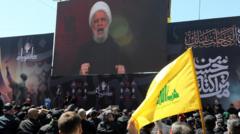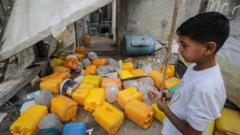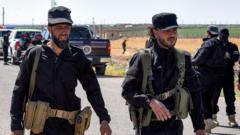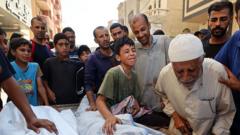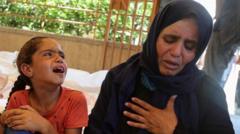Recent reports indicate that at least 410 Palestinians have lost their lives due to Israeli military actions while seeking assistance in the Gaza Strip, prompting a scathing critique from UN officials regarding the ongoing aid distribution processes.
UN Critiques Gaza Humanitarian Aid Amid Fatal Fire Incidents
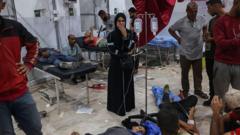
UN Critiques Gaza Humanitarian Aid Amid Fatal Fire Incidents
The UN condemns the distribution of aid in Gaza as a "death trap," following the deaths of 46 individuals by Israeli gunfire.
At least 46 individuals are reported dead from gunfire while waiting for aid in Gaza, according to local hospitals. Chaos erupted at al-Awda hospital in Nuseirat, where gunshot victims flooded in, leading to harrowing scenes of sorrow. The incidents highlight a continuity of violence against civilians in the area, as individuals attempt to secure essential food supplies.
Umm Raed al-Nuaizi, a mother whose son was critically wounded while collecting food for his family, expressed profound heartbreak, asking, "Why are our children's lives seen as so cheap?" Her account reflects a broader sentiment among Gazans facing escalating violence just to procure basic necessities.
In separate incidents, rescuers reported that at least 25 others were also killed near another aid site in southern Gaza. Eyewitness accounts detail how Israeli forces opened fire without prior warning. The Israel Defense Forces (IDF) have stated that they are reviewing reports regarding the casualties connected to their actions, alleging that those gathered were in proximity to IDF operations.
In light of these events, UN agencies have condemned the aid distribution model endorsed by the US and Israel, with an official branding it as a "war crime" for weaponizing humanitarian assistance. Philippe Lazzarini, head of the UN agency for Palestinian refugees, described the mechanism as a "death trap" that dehumanizes desperate civilians. The IDF claims to support alternative aid distributions through controlled channels, despite the ongoing criticism from major aid organizations for collaborating with this new model.
Amidst this turmoil, residents of Gaza, like Mahmoud al-Ghura, express deep fear over attempting to access aid. He described previous attempts as tantamount to entering "death zones," leaving many to risk hunger rather than confront the dangers of obtaining food aid.
As the situation remains dire, aid organizations continue to navigate the complicated dynamics of humanitarian delivery in a conflict zone, facing accusations of complicity while trying to address the urgent needs of the Gazan population.
Umm Raed al-Nuaizi, a mother whose son was critically wounded while collecting food for his family, expressed profound heartbreak, asking, "Why are our children's lives seen as so cheap?" Her account reflects a broader sentiment among Gazans facing escalating violence just to procure basic necessities.
In separate incidents, rescuers reported that at least 25 others were also killed near another aid site in southern Gaza. Eyewitness accounts detail how Israeli forces opened fire without prior warning. The Israel Defense Forces (IDF) have stated that they are reviewing reports regarding the casualties connected to their actions, alleging that those gathered were in proximity to IDF operations.
In light of these events, UN agencies have condemned the aid distribution model endorsed by the US and Israel, with an official branding it as a "war crime" for weaponizing humanitarian assistance. Philippe Lazzarini, head of the UN agency for Palestinian refugees, described the mechanism as a "death trap" that dehumanizes desperate civilians. The IDF claims to support alternative aid distributions through controlled channels, despite the ongoing criticism from major aid organizations for collaborating with this new model.
Amidst this turmoil, residents of Gaza, like Mahmoud al-Ghura, express deep fear over attempting to access aid. He described previous attempts as tantamount to entering "death zones," leaving many to risk hunger rather than confront the dangers of obtaining food aid.
As the situation remains dire, aid organizations continue to navigate the complicated dynamics of humanitarian delivery in a conflict zone, facing accusations of complicity while trying to address the urgent needs of the Gazan population.










